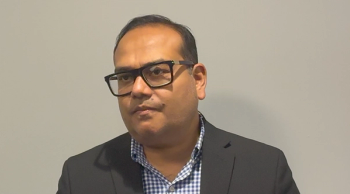
Oncology NEWS International
- Oncology NEWS International Vol 17 No 3
- Volume 17
- Issue 3
Is benefit of trastuzumab limited to first 18 months?
Four-year follow-up of the French/Belgian PACS-04 trial in early breast cancer found a trend toward benefit with sequential trastuzumab (Herceptin) in the first 18 months but, somewhat surprisingly, no difference in disease-free survival at 4 years. Marc Spielmann, MD, of the Institute Gustave Roussy, Villejuif, France, reported the findings at the 2007 San Antonio Breast Cancer Symposium (abstract 72).
SAN ANTONIO-Four-year follow-up of the French/Belgian PACS-04 trial in early breast cancer found a trend toward benefit with sequential trastuzumab (Herceptin) in the first 18 months but, somewhat surprisingly, no difference in disease-free survival at 4 years. Marc Spielmann, MD, of the Institute Gustave Roussy, Villejuif, France, reported the findings at the 2007 San Antonio Breast Cancer Symposium (abstract 72).
The randomized multicenter, phase III PACS-04 trial evaluated the benefit of concomitant docetaxel (Taxotere) and epirubicin (Ellence) vs an anthracycline-based regimen (FEC), followed by trastuzumab vs observation as adjuvant therapy of node-positive early breast cancer.
The investigators randomized 3,010 women to six cycles of either concomitant epirubicin 75 mg/m2 plus docetaxel 75 mg/m2 every 3 weeks or fluorouracil (5-FU) 500 mg/m2 plus epirubicin 100 mg/m2 plus cyclophosphamide 500 mg/m2 (FEC100) every 3 weeks. Chemotherapy was followed by radiotherapy and hormonal therapy as indicated.
A second randomization occurred when HER2 status became available. Patients who were HER2 positive (n = 528) were randomized to observation only or to 1 year of trastuzumab 6 mg/kg every 3 weeks.
In the intent-to-treat analysis of the HER2-positive population at a median follow-up of 48 months, breast cancer events occurred in 70 of 268 patients with observation and in 59 of 260 receiving trastuzumab [234 actually received trastuzumab].
The 3-year disease-free survival was 77.9% in the observation arm and 80.9% in the trastuzumab arm. At 4 years, it was 73.2% and 72.7%, respectively (P = .41).
In an exploratory analysis, the hazard ratios (HRs) for first events were strikingly different between the first 18 months and the last 30 months of the study (see Figure). From the time of randomization (approximately 6 months after trial enrollment), the HR was 0.57 at month 18 but 1.04 at month 48. The overall HR for the 4-year outcome was 0.86.
Although there was a trend for benefit with sequential trastuzumab in the first 18 months, all benefit disappeared by 48 months, Dr. Spielmann said. Similarly, overall survival did not differ at 48 months-93.0% for observation and 91.5% with trastuzumab (HR 1.27).
Due to strict rules for treatment discontinuation for cardiac toxicity, 42 patients stopped trastuzumab; however, only 4 patients (1.7%) developed heart failure. An asymptomatic decline in left ventricular ejection fraction less than 45% was experienced by 11 patients on trastuzumab and 6 in the observation arm.
Results a ‘departure’
Dr. Spielmann noted that the findings are a departure from the majority of other studies of trastuzumab in the adjuvant setting. The HR of 0.86 at 4 years is the least robust among seven major studies. The HERA trial, for example, produced an HR of 0.54 in 1-year follow-up.
“PACS-04 is the only trial not showing a significant effect with trastzumab,” he noted, pointing out that statistical power, duration of trastuzumab, sequential as opposed to concomitant use, and delayed start of trastuzumab are issues that could be explored.
An inkling of things to come?
In an interview with ONI, Peter Ravdin, MD, PhD, of M.D. Anderson Cancer Center and The University of Texas Health Sciences Center at San Antonio, suggested that the PACS-04 results could be an inkling of things to come, once other study populations mature to this degree.
For instance, the HERA trial showed nearly a 50% reduction in recurrences at 1 year, but the results at 2 years “were less positive,” Dr. Ravdin noted. “The hazard ratios came closer together [from 0.54 to 0.64], and one would expect that at 4 years this trend would continue.…There is the possibility that the more pessimistic view we get from PACS-04 may also be seen in HERA.”
Crossover rate critical
Dr. Spielmann told ONI that no patients in the observation arm of PACS-04 received trastuzumab prior to disease recurrence, but only in the metastatic setting, ie, crossover did not occur. This is critical, Dr. Ravdin pointed out.
“In HERA, the crossover rate was about 50%. The investigators felt this did not affect their results, but we have not seen those curves,” he said. “In PACS-04, the lack of crossover means that trastuzumab’s apparent lack of effect on late recurrence is not due to the blunting effect of crossover-which has been suggested as a possible explanation of the lack of late efficacy in HERA, where there was massive crossover.”
The findings, therefore, raise very serious concerns. “It would suggest that there will be a very favorable early impact of the drug, but little effect on late outcomes. And this would be a huge disappointment,” Dr. Ravdin said.
The PACS-04 findings may indicate that sequential delivery is not optimal, he added. Trials evaluating sequential chemotherapy followed by trastuzumab have produced a consistent picture of a lack of effect on recurrences after 18 months. In contrast, the NSABP B-31 and the NCCTG 9831 trials, which evaluated concurrent delivery, actually do demonstrate efficacy beyond 18 months, Dr. Ravdin noted.
“The update of NCCTG presented by Dr. Edith Perez last year shows apparent suppression of recurrences out to 5 years,” he said.
PACS-04, therefore, strengthens the hypothesis that concurrent administration of chemotherapy and trastuzumab might be better, he emphasized.
“Nothing is definitive as yet,” he said, “but this argues that concurrent use of these agents may be important.”
Articles in this issue
over 17 years ago
Recentin headed to phase III in first-line colon caover 17 years ago
Topo 2 alpha test FDA approvedover 17 years ago
RFA provides sustained pain relief in osteoid osteomaover 17 years ago
Renal ca surgery often determined by doctors’ practice styleover 17 years ago
Partial nephrectomy underutilized for small renal tumorsover 17 years ago
Most older men with early-stage cancer can avoid treatmentover 17 years ago
SERM reduces ADT side effectsover 17 years ago
New serum biomarker appears to detect colon cancerover 17 years ago
Hypofractionated IMRT does not increase sexual side effectsover 17 years ago
Surface mapping aligns patients for external beam PBINewsletter
Stay up to date on recent advances in the multidisciplinary approach to cancer.




















































































